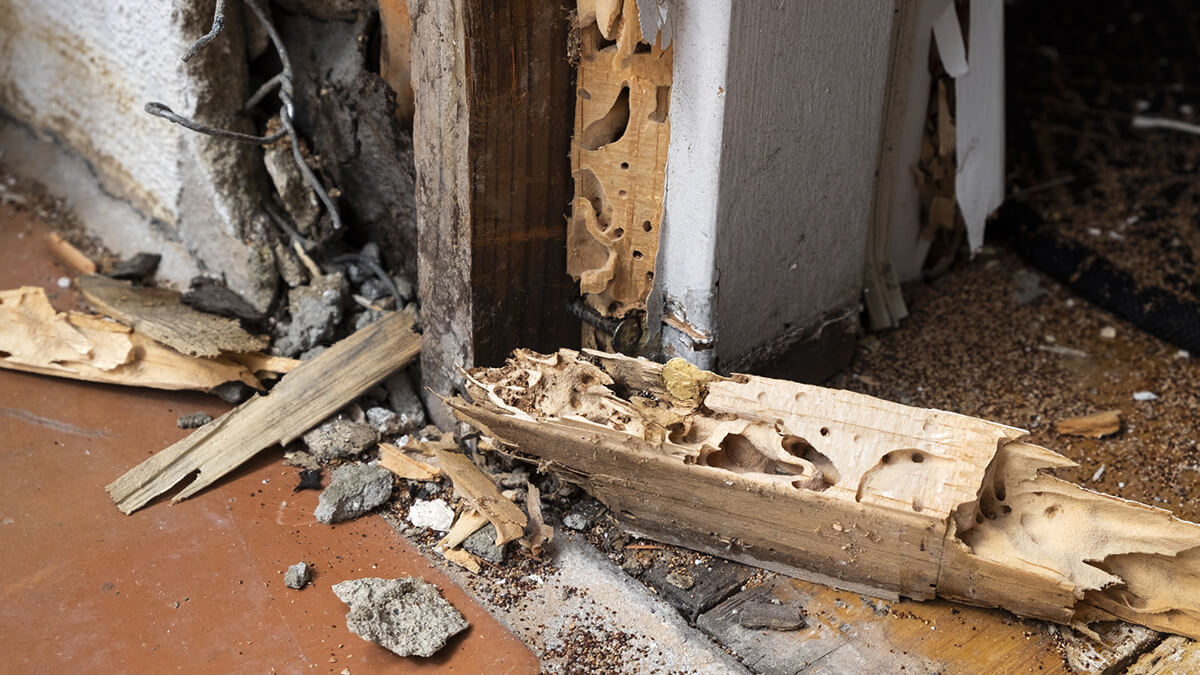Selling a house with a history of termites can be challenging. Buyers often have concerns about structural integrity and future infestations. Addressing these issues head-on is crucial for a successful sale. Understanding termite problems, properly treating any infestations, and transparently disclosing the history can make the process smoother.
iBuyer.com can help streamline the sale of homes with termite issues, offering a fast and efficient solution. Their expertise in handling such cases ensures a hassle-free transaction for homeowners.
Compare Cash Offers from Top Home Buyers. Delivered by Your Local iBuyer Certified Specialist.
One Expert, Multiple Offers, No Obligation.
Sell a House With Termite History
Understanding Termite Issues
What are Termites?
Termites are small, wood-destroying insects that can cause significant damage to homes. They primarily feed on wood and other materials containing cellulose, making them a major concern for homeowners. The most common types of termites include:
- Subterranean Termites: These termites live underground and build mud tubes to access above-ground food sources. They are the most destructive type and can cause extensive damage to homes.
- Drywood Termites: These termites infest dry wood and do not require contact with soil. They are often found in attics and wooden furniture.
- Dampwood Termites: Preferring moist wood, these termites are less common in homes but can be problematic in areas with high humidity.
Understanding the type of termite infestation is crucial for effective treatment and prevention.
Signs of Termite Damage
Detecting termite damage early can save homeowners from extensive repairs. Common signs of termite damage include:
- Mud Tubes: Subterranean termites build mud tubes for protection and moisture as they travel between their colony and food sources.
- Hollow-sounding Wood: When termites consume wood from the inside out, it leaves a hollow sound when tapped.
- Droppings: Drywood termites leave small, pellet-shaped droppings near infested areas.
- Frass: A term for termite droppings that looks like sawdust or sand.
- Buckling Floors: Warped or buckling floors can indicate termite activity below the surface.
- Cracked or Bubbling Paint: Termites can create moisture build-up, causing paint to bubble or peel.
Regular inspections and early detection are key to managing termite infestations effectively.
Assessing the Severity of Termite Damage
Professional Inspection
When selling a house with a history of termites, it is crucial to determine the extent of the damage. A professional termite inspection is the best way to achieve this. Here’s what to expect during the inspection process:
- Thorough Examination: A licensed termite inspector will conduct a comprehensive inspection of the property, focusing on common termite hotspots such as basements, crawl spaces, attics, and foundations.
- Identification of Termite Types: The inspector will identify the type of termite present, as different species require different treatment approaches.
- Extent of Damage: The inspector will assess the extent of the damage, identifying areas that need immediate attention and repair.
- Inspection Costs: Typically, a professional termite inspection can cost between $75 to $150, depending on the size of the property and the region.
Understanding Inspection Reports
Once the inspection is completed, the inspector will provide a detailed report outlining the findings. Here’s how to interpret the inspection report:
- Infestation Details: The report will specify the type of termites found and the severity of the infestation.
- Damage Assessment: It will detail the extent of the damage, including areas affected and the structural integrity of the property.
- Recommended Treatments: The report will suggest treatment options to eliminate the termite infestation, ranging from localized treatments to full fumigation.
- Repair Recommendations: If necessary, the report will recommend repairs to fix the termite damage and prevent future infestations.
Addressing Termite Issues
Termite Treatment Options
When it comes to addressing termite infestations, several treatment options are available. Each method varies in effectiveness and cost, depending on the severity of the infestation and the type of termites present.
- Fumigation: This method is often used for severe infestations, particularly with drywood termites. The entire house is tented and filled with a gas that kills termites. Fumigation is highly effective but can be costly, typically ranging from $1,200 to $2,500 for a 1,250-square-foot house.
- Liquid Termite Treatments: These involve applying a liquid termiticide around the foundation of the home. This creates a barrier that kills termites and prevents future infestations. Costs range from $3 to $16 per linear foot, depending on the termiticide used and the size of the property.
- Bait Systems: Baiting involves placing bait stations around the house. Termites consume the bait and carry it back to their colony, eventually killing the entire colony. This method is less invasive than fumigation and costs around $2,500 for installation and monitoring.
- Localized Treatments: For minor infestations, localized treatments such as spot treatments with liquid termiticides or heat treatments can be effective. Costs vary widely but are generally lower than whole-house treatments, ranging from $200 to $900.
Repairing Termite Damage
After treating the infestation, it is essential to repair any termite damage to restore the property’s structural integrity and aesthetic appeal.
- Common Repairs: These may include replacing damaged wood, reinforcing weakened structures, and repairing any cosmetic damage such as holes or sagging floors.
- Cost of Repairs: Repair costs can vary significantly based on the extent of the damage. Minor repairs might cost a few hundred dollars, while extensive structural repairs can run into thousands of dollars. On average, homeowners can expect to spend between $300 and $3,500 on termite damage repairs.
Legal and Disclosure Requirements
Disclosure Obligations
When selling a house with a history of termite damage, transparency is crucial. Federal and state laws mandate the disclosure of any known issues that could affect the property’s value or safety, including termite damage.
- Federal Requirements: The Federal Trade Commission (FTC) requires sellers to disclose any significant issues that could affect the property’s value. This includes past and present termite infestations and any repairs conducted to address the damage.
- State Requirements: State laws vary, but most require comprehensive disclosure forms where sellers must report any known termite damage or infestations. For example, in California, the Real Estate Transfer Disclosure Statement (TDS) mandates that sellers disclose any termite damage, treatments, and any warranties related to termite control.
- Local Regulations: Some municipalities have additional regulations regarding the disclosure of termite damage. It’s essential to check local requirements to ensure compliance.
Importance of Transparency
Failing to disclose known termite issues can lead to severe legal repercussions. Buyers who discover undisclosed damage after the sale can sue for damages, and sellers might face significant fines and penalties.
- Avoiding Legal Complications: By being upfront about the termite history, sellers can avoid potential lawsuits and disputes. This transparency helps build trust with potential buyers and can facilitate a smoother sale process.
- Providing Documentation: It’s beneficial to provide potential buyers with documentation of past inspections, treatments, and repairs. This includes receipts, warranties, and reports from termite control professionals. Such documentation can help reassure buyers that the issue has been addressed adequately.
Pricing Your Home with Termite History
Setting a Competitive Price
When selling a house with a history of termite damage, setting a competitive price is essential to attract buyers despite the property’s past issues. Here are some strategies to consider:
- Realistic Pricing: Evaluate the extent of the termite damage and any repairs made. Adjust the price accordingly to reflect the property’s condition. Pricing too high can deter buyers, while pricing too low might raise suspicions about hidden issues.
- Market Comparison: Conduct a Comparative Market Analysis (CMA) to understand how similar properties in your area are priced. This analysis will help set a competitive price that considers the local market conditions.
- Consult a Professional: Real estate agents with experience in selling homes with termite history can provide valuable insights. They can help determine a fair market value and suggest the best pricing strategy to attract buyers quickly.
- Factor in Repairs: If you’ve already addressed termite damage, factor the cost of repairs into your asking price. Highlighting the completed repairs can reassure buyers and justify a higher price.
Offering Incentives
To further attract potential buyers, consider offering incentives that can make your property more appealing despite its termite history.
- Repair Credits: Offer repair credits to cover future termite inspections or minor repairs. This approach can provide buyers with peace of mind and reduce their out-of-pocket expenses after purchasing the home.
- Home Warranty: Providing a home warranty that covers termite treatment and damage for a specific period can alleviate buyers’ concerns. It shows that you’re committed to standing by the property’s condition.
- Flexible Closing Terms: Being flexible with closing terms, such as a quick closing date or covering some closing costs, can make your property more attractive to buyers.
Market Conditions
Understanding the current real estate market conditions is crucial when pricing your home. Here are some factors to consider:
- Seller’s Market: In a seller’s market, where demand exceeds supply, you might have more flexibility in pricing despite the termite history. Buyers may be more willing to overlook past issues in a competitive market.
- Buyer’s Market: In a buyer’s market, where supply exceeds demand, pricing competitively is even more critical. Buyers have more options, so ensuring your home stands out with a fair price is essential.
- Seasonal Trends: Real estate markets can fluctuate seasonally. Research local market trends to determine the best time to list your home. Spring and summer are typically peak seasons for real estate, potentially offering better selling conditions.
Marketing Your Home with Termite History
Creating an Effective Listing
When marketing a home with a termite history, transparency and honesty are key. An effective listing should balance highlighting the property’s strengths while being upfront about its past issues. Here’s how to create a compelling listing:
- High-Quality Photos: Use professional photos to showcase your home’s best features. Ensure the images are well-lit and highlight the property’s unique aspects. While it’s important to be honest about the termite history, focusing on the home’s positive attributes can attract more buyers.
- Detailed Descriptions: Provide a thorough description of the property, including the number of bedrooms, bathrooms, and any recent renovations or upgrades. Mention the termite history and what has been done to address it. Transparency builds trust with potential buyers.
- Highlighting Potential: Emphasize the property’s potential for buyers. If repairs have been made, highlight these improvements and reassure buyers that the issue has been resolved. For example, if you’ve replaced damaged wood or installed preventative measures, include this information in the listing.
Targeting the Right Buyers
Not all buyers will be deterred by a termite history, especially if the issue has been properly addressed. Here’s how to target the right audience:
- Investors and Flippers: Investors looking for properties to renovate and resell might be less concerned about the termite history, especially if the price is right. Highlight the investment potential in your listing.
- Cash Buyers: Cash buyers often seek properties that they can purchase quickly and might be more willing to deal with termite issues. Mention in your listing that you welcome cash offers.
- Eco-Friendly Buyers: If your termite treatment included eco-friendly methods, this could appeal to buyers who prioritize sustainable living. Highlight any green certifications or eco-friendly measures taken.
- Using Online Platforms: List your property on popular real estate websites and platforms where it will get the most exposure. Use targeted advertising to reach specific buyer demographics interested in fixer-uppers or investment properties.
- Leveraging Social Media: Utilize social media to market your home. Share the listing on platforms like Facebook, Instagram, and Twitter, using relevant hashtags to reach a broader audience.
Selling Options for Homes with Termite History
iBuyer.com Solution
iBuyer.com offers a streamlined process for selling your home, even if it has a history of termite damage. Here’s how it works:
✅ Advantages of iBuyer.com:
- Quick Offers: iBuyer.com provides instant cash offers, allowing you to sell your home quickly without waiting for traditional market processes.
- No Need for Repairs: You can sell your home as-is, without spending time or money on termite treatments or repairs.
- Hassle-Free Process: iBuyer.com handles all paperwork and disclosure requirements, simplifying the selling process for you.
- Flexible Closing Dates: You can choose a closing date that suits your timeline, providing flexibility and convenience.
Selling As-Is
Selling a home “as-is” means selling the property in its current state without making any repairs or improvements. This approach has both advantages and challenges, especially when dealing with termite history.
✅ Benefits of Selling As-Is:
- Time-Saving: Selling as-is can significantly speed up the selling process. You avoid the time-consuming repairs and renovations, making it possible to sell the home more quickly.
- Cost-Effective: You save money by not investing in repairs or improvements, which can be particularly beneficial if the termite damage is extensive and costly to fix.
- Attracting Certain Buyers: As-is properties can attract investors, flippers, and cash buyers who are looking for properties to renovate and resell. These buyers are often more willing to take on the risks associated with termite damage.
🟥 Challenges of Selling As-Is:
- Lower Sale Price: Homes sold as-is typically sell for less than those that have been repaired and improved. Buyers will factor in the cost of necessary repairs when making their offers.
- Limited Buyer Pool: Not all buyers are interested in taking on a property with known issues, which can reduce the number of potential buyers.
- Disclosure Requirements: Even when selling as-is, you must disclose known termite issues. Failure to do so can result in legal complications.
Traditional Real Estate Market
Listing your home on the traditional real estate market involves working with a real estate agent to find a buyer. This method can be effective, but it’s important to understand the pros and cons.
✅ Pros of Using a Real Estate Agent:
- Professional Guidance: Real estate agents provide expertise in pricing, marketing, and negotiating, which can help you get the best possible price for your home.
- Wider Reach: Agents have access to Multiple Listing Services (MLS) and other marketing tools that can expose your home to a larger audience.
- Negotiation Skills: Experienced agents can help negotiate better terms and handle buyer objections regarding the termite history.
🟥 Cons of Using a Real Estate Agent:
- Commission Fees: Agents typically charge a commission (usually around 5-6% of the sale price), which can reduce your net proceeds.
- Potentially Longer Process: Selling through an agent can take longer than other methods, as you need to wait for the right buyer and go through traditional closing procedures.
- Buyer’s Inspections: Potential buyers will likely conduct their own inspections, which could bring up the termite history again and possibly lead to renegotiations.
Conclusion
Selling a house with a history of termites presents unique challenges, but understanding these issues and addressing them appropriately can facilitate a successful sale.
By conducting a professional inspection, addressing necessary repairs, and being transparent about the property’s history, you can attract buyers and achieve a fair price for your home. Pricing the home competitively and marketing it effectively are crucial steps in this process.
If you prefer a hassle-free selling experience, consider using iBuyer.com. We simplify the process by handling all disclosure requirements and offering competitive cash offers, allowing you to sell your home quickly and efficiently without the need for extensive repairs.
Instant Valuation, Confidential Deals with a Certified iBuyer.com Specialist.
Sell Smart, Sell Fast, Get Sold. No Obligations.
FAQs
Yes, you can sell a house with a history of termites. However, it’s essential to address the issue by treating the infestation and repairing any damage. Transparency with potential buyers about the termite history and the steps you have taken to resolve the problem is crucial to avoid legal complications and gain buyer trust.
The cost of termite treatment varies depending on the severity of the infestation and the method used. Professional treatments can range from $500 to $3,000 or more. DIY treatments are generally cheaper but may not be as effective for severe infestations. It’s advisable to consult with a professional to determine the best course of action and get an accurate estimate.
Termite history can impact your home’s market value, as potential buyers may be concerned about recurring issues and the structural integrity of the property. Properly addressing and documenting the treatment and repairs can help mitigate these concerns. Offering repair credits or a warranty on the termite treatment can also make the property more appealing to buyers.




